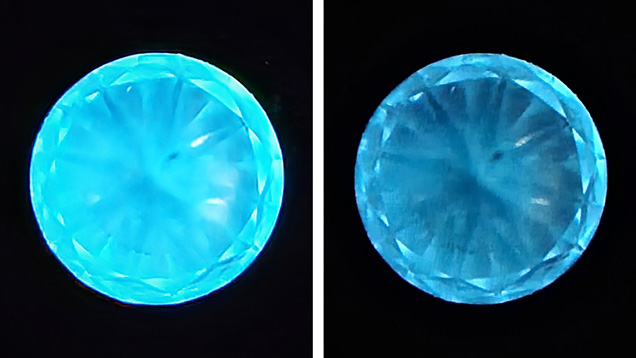Rare Mixed Type IaB-IIb Diamond with a Long-Lasting Phosphorescence
Phosphorescence is an optical effect in which electromagnetic radiation absorbed by a substance is released relatively slowly in the form of light. Long-lasting UV phosphorescence of more than 10 seconds’ duration is an extremely rare property in natural diamonds, normally limited to hydrogen-rich type Ia chameleon and type IIb diamonds.
Recently, a natural round brilliant weighing 0.20 ct (E-F color, VS2-SI1 clarity) was submitted to Stuller Inc. by a client for a custom design. During our diamond screening process, using a phosphorescence imaging-based screening device, the diamond was automatically identified as having an HPHT-grown origin, conflicting with the client’s natural origin disclosure. Secondary testing, using a fluorescence spectroscopy-based screening device, identified the diamond as having a natural origin. Under magnification, only a few pinpoints were spotted.
Due to the ambiguous results, the gem was sent to Stuller’s Gem Lab for further analysis. The FTIR spectrum (figure 1) showed a mixed diamond type comprising low levels of aggregated nitrogen (IaB) and boron (IIb), indicating a natural origin. Similar results were given using fluorescence spectroscopy, which identified N3 peaks, associated with natural origin. Photoluminescence spectroscopy, using a 532 nm laser under liquid nitrogen temperature (77 K), provided results supporting the other instruments and confirming the absence of synthetic origin-related peaks.

In order to identify the cause of the false positive results from the first screening device, the diamond was placed in a SWUV cabinet to analyze its phosphorescence effect. Once excited, the stone emitted a strong bluish green phosphorescence for about 120 seconds (figure 2).
The emitted color and the unusually long duration of the effect are typically associated with HPHT-grown diamonds. Consequently, these properties triggered the false positive results in the phosphorescence imaging-based screening device. In this case, the rare combination of natural diamond types, which includes a boron component, was probably the reason for the unusual phosphorescence.
This case demonstrates the complexity of diamond origin identification and the need for multiple diamond screening devices, each with a different screening technology, to cover all possibilities and ensure a 100% correct identification.



